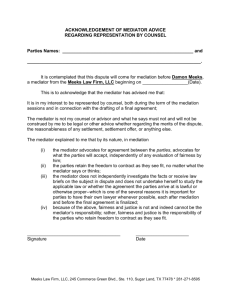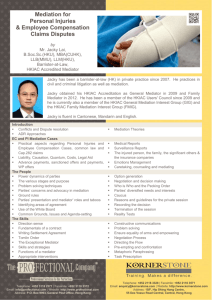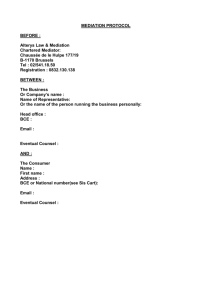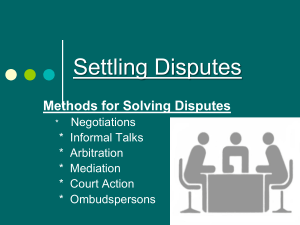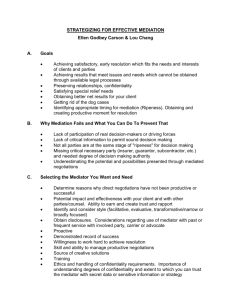Communication Skills in Mediation - National Association of Realtors
advertisement
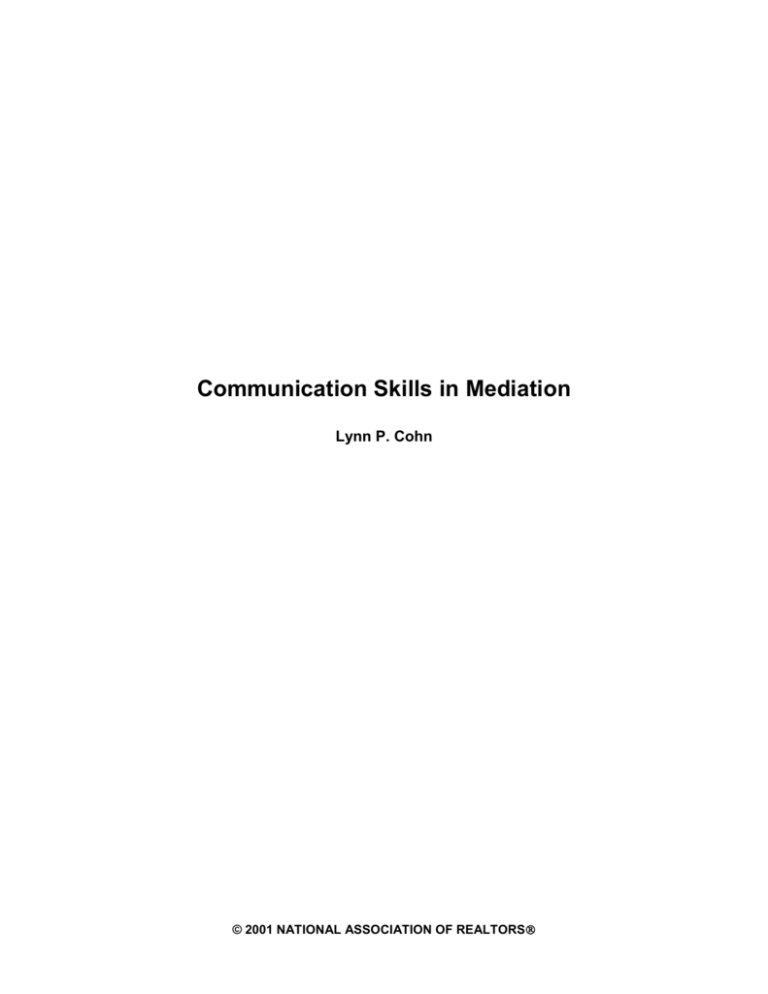
Communication Skills in Mediation Lynn P. Cohn © 2001 NATIONAL ASSOCIATION OF REALTORS Communication Skills in Mediation Effective communication is at the core of successful mediation. Many people take for granted the role of communication in relationships. Those who strive to become mediators need to approach communication as an area worthy of analysis and practice. Afterall, mediators not only need to use strong communication skills to understand a dispute and to connect to parties; they also need to help the parties to engage in a constructive exchange when their own poor communication skills may be at the heart of the conflict. Key communication skills in mediation are: listening summarizing dealing with emotions effective questioning neutralizing reframing Listening Skills in Mediation Effective listening -- there is no substitute! While mediation is very forgiving of mediator error, a mediator’s failure to listen, rather than “just hear,” may be fatal. When you hear, you take in sound. When you listen, you process the information received. How to Listen Prepare Yourself Consciously transition to role of mediator Quiet your mind Engage in Active Listening Stop talking Focus on the speaker Take your time Maintain eye contact/attentive posture Acknowledge what is being said/suggested Acknowledge emotions Look for non-verbal cues Empathize Clarify Avoid assumptions Summarize Rewards for Effective Listening Parties feel heard Parties trust the mediator, the process and, perhaps, each other Mediator obtains a clear understanding of the conflict Mediator obtains key information (what is said and not said) Provides a model of appropriate communication skills for parties Mediation Summarizing Skills Summarizing is a mediator’s compass helping to keep everyone on the same track. Summarizing involves reflecting back to a speaker the essence of the communication. In order to summarize, a mediator must focus carefully on the message. Reasons to Summarize Allow parties to feel heard Transition to new topic Identify underlying emotions/concerns Focus parties on problem solving Encourage parties that progress has been made Point out different views Keep track of the deal Summarization Tips Be concise Choose your words carefully Move beyond words Omit blame Leave your judgment out of the summary, be neutral Ask if you are correct Paraphrase only if sensitive issue or precise wording is key Key Phrases for Summarizing “As I hear you . . .” “Let’s see where we are . . .” “I’ve heard you say . . .” “We’ve resolved these issues . . .” “You’ve agreed on . . .” “We are still left with the issues of . . .” “What you are saying is . . .” When in doubt, summarize! Dealing with Emotions in Mediation Conflict and emotion go hand-in-hand. A mediator needs to deal with the emotions connected to the parties’ dispute. A failure to recognize and address the emotional underpinning of a problem will often make resolution in mediation impossible. On the other hand, when parties feel their emotions have been acknowledged they have less need to constantly repeat themselves and can move forward. Acknowledging Emotions Acknowledging emotions involves naming the emotion you perceive the person to be experiencing. Until emotions are given an appropriate place at the table, parties may need to act out or repeat themselves. These barriers to resolution in mediation may melt away once parties feel understood. Acknowledging emotions does not include agreeing with or sympathizing with a party’s emotion, judging a party’s emotions, or taking action to “fix” a party’s feelings. The mediator should place the emotion on the party and not take it on personally. Examples of acknowledgement of emotion include: Do say “You seem really upset.” Do not say “I would be upset, too.” Do say “It sounds like you have been frustrated for years.” Do not say “I understand how frustrating it is.” Emotionally Difficult Situations Intense Anger Stay calm – check your response Acknowledge the emotion Don’t reciprocate (even if directed at you) Allow venting Draw the line at destructive anger Intense Anguish Stay calm – check your response Acknowledge the emotion Normalize the emotion Offer comfort (tissue, pause, break if party desires) Do not lose neutrality Effective Questioning in Mediation Role of Questioning in Mediation Effective questioning serves many functions in mediation, such as: gathering information clarifying or understanding refocusing a wandering speaker stimulating thinking opening up a position closing in on a decision NOTE: The goals and type of questioning may vary, depending on whether the mediator uses a facilitative, evaluative, or transformative approach. Types of Questions Open Open questions help obtain information, and help a party to open up. Some open questions (and statements) include the following. “Tell me more about this . . .” “How does this affect you?” “What was your understanding of the situation?” “Can you describe . . .” Use open-ended questions/statements early in the mediation to: gain an understanding of the problem allow parties to vent establish rapport Closed Closed questions, such as those listed below, require a one-word or two-word answer, often a “yes”, or a “no”. Did you tell her . . .? Did you call him . . .? Where were you when . . .? Use closed questions to: re-focus a rambler direct a party to an issue check details get a quick response Neutralizing Language Parties to mediation often are upset and might use inflammatory language. Requiring parties to refrain from using blaming, angry, or adversarial words as a ground rule for mediation might sanitize the atmosphere to the point that an honest exchange of thoughts and emotions becomes impossible. However, a mediator must always refrain from using such language. Yet, a mediator is left with the job of dealing with unpleasant words and the feelings behind them. This task is accomplished by neutralizing the language. Neutralizing involves going around the incendiary words to reach the feelings or interests behind them. Example Party: “She is an untrustworthy liar, and would take advantage of her own mother.” Mediator: “You are concerned with being treated fairly and honestly.” The mediator’s neutralizing language allows the parties to move forward to a negotiable issue, such as how each party would like to be treated. Reframing Skills in Mediation Perhaps the most sophisticated and difficult communication skill for a mediator to master is the art of reframing an issue presented to move toward resolution. Reframing involves taking a statement or a concern, then focusing on specific behaviors or options to be negotiated related to the statement or concern. Ultimately, reframing allows parties to look at a situation from a different perspective. Reasons to Reframe Turn a negative to a positive Turn from complaints to negotiable behaviors Move from the past into the future Keep the discussion moving Example Party: “We have been at this all day and have not made progress.” Mediator: “What can you do to help us get this done?” Example Party: “I can’t trust her because she tries to steal my clients.” Mediator: “How would you like her to deal with your clients?” Artful reframing is a wonderful tool for breaking away from the complaints and positions of the parties and moving towards solutions.
